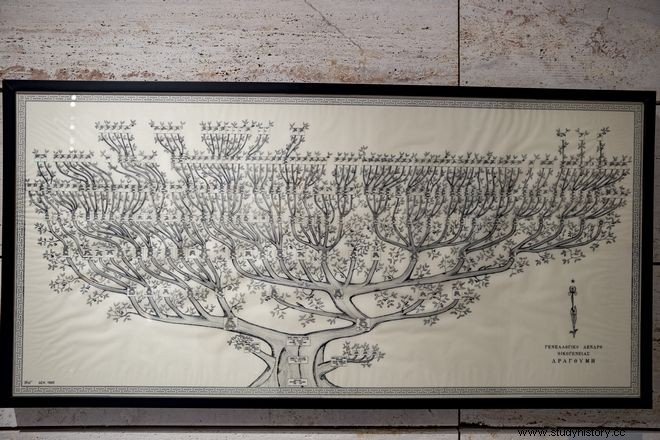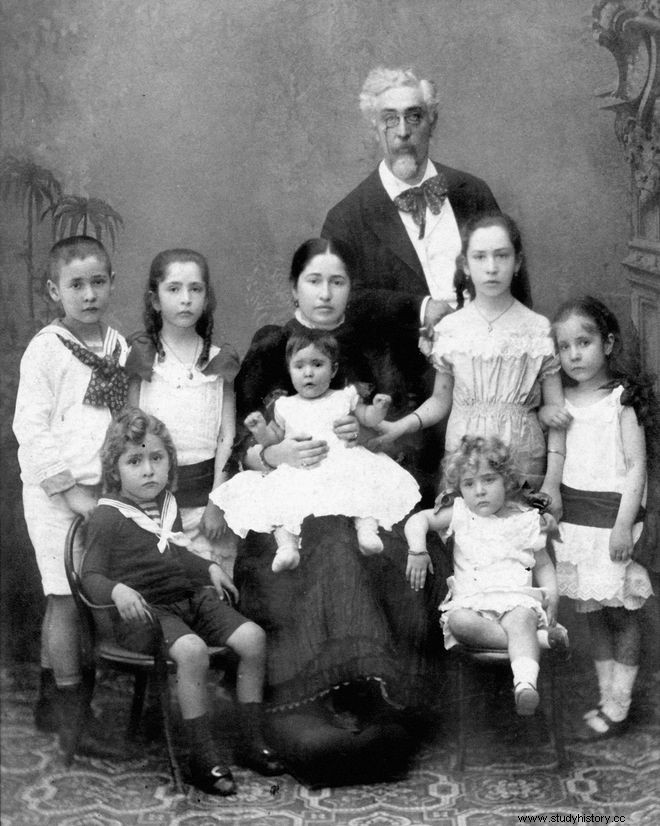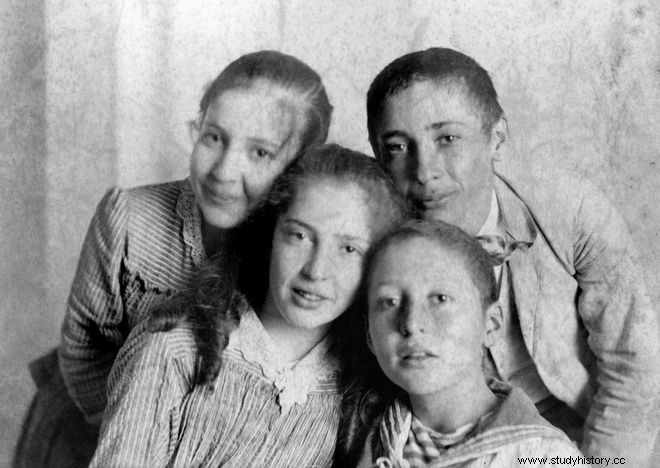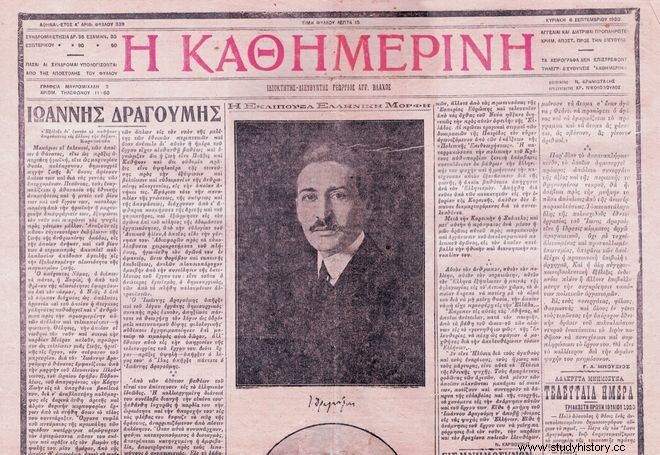"Sweet-blooded and mortally hated man of drawing-rooms and committees. Populist and scion of purists, modest and amorous, enemy of the small and honest Greece but brotherly friend of the king until his death by Eleftherios Venizelos and common visionary of a different kind of Greece. All these pearls do not just make up a mysterious name but give birth to a personal mythology that filled me with fascination throughout my early youth." With these words, Odysseus Elytis describes the multifaceted personality of the diplomat, politician and writer Iona Dragoumis, which is revealed in the exhibition organized by the American School of Classical Studies in Athens (ASKSA).
In the common consciousness, Dragoumis has been imprinted as the forbidden desire of Penelope Delta, the great political rival of Eleftherios Venizelos, the champion of populism and a central figure of the Macedonian Struggle. Undoubtedly, all these are aspects of him, but they do not capture the significant personality of a sharp "pen" (after all, Dragoumis was never a keen orator) with a vision for Greece that was misinterpreted.

A wooden trunk with a handwritten note "Archion Ionos infidentikon (for liquidation)" that kept the secrets of the Dragoumi archive sealed for years (and for which there was a condition from its donor not to be opened until "the next generation"), photos from Ionos's childhood, his school notebooks, his diaries, encrypted letters, manuscripts of his articles and books and rare publications from his personal library are just some of the treasures that the exhibition hosts.
It is worth noting that the aim of the organizers is to make the visitor's experience as experiential as possible. Thus, from the very first step you enter the atmosphere of the time, listening to musical pieces that Ionas Dragoumis himself had singled out on a page of his diary on July 17, 1896.
We spoke with the curator of the exhibition and archive manager of ASKSA Ms. Natalia Vogeikov-Brogan for Dragoumis, the clause in the release of his file and the battles he fought, which remain terribly relevant today:
Who is Ion Dragoumis for you?
"He was a multifaceted personality. "I'm not one, I'm many" he himself had said, and his brother Philip later said that Ionas "is unclassifiable, you can't put him in a box". Personally, this fascinates me:I don't think that she is contradictory, but that she is a very important personality and that is what we wanted to show through the exhibition.
When did his file come into your possession?
"We've had the archive with us since 1959 but it was first opened in 1980. Many times the donors of the archives impose some conditions on the material being made available to the public, which we respect. His brother Iona Dragoumi was alive as were many people mentioned in his record, so the condition was set that it would not be opened until the next generation. The reason for this term is usually the protection of those involved:There are very sensitive elements, especially in Dragoumi's diaries in which he talked about, among other things, his illicit relationship with Penelope Delta. Today this relationship is known, but then it was a sealed secret."

What were the challenges you faced while organizing the exhibition?
“I think the biggest challenge that arose is that - given that the exhibition presents archival material - there are very few three-dimensional objects that can be attractive to the visitor. We worked with the excellent design team to find ways to present this seemingly 'boring' material as a story that one can follow from beginning to end."
How long did the digitization of the material take?
"Digitalization started in 2008 with the Information Society. It was our first digitization along with other files. A bit was digitized then - mostly letters - and this year we digitized a lot of his diaries. Digitization is an expensive story".
Which exhibit do you stand out?
"The maps, especially the handwritten map of Macedonia that was saved because it shows the distribution of populations in eastern Macedonia at the beginning of the 20th century. Many of our visitors stand and study him. I also single out a lithograph found in the section of the Organization of Constantinople that is related to the revolution of the Young Turks. It depicts the Sultan and representatives of various religions, Greeks, Armenians. We found it by chance in the archive of Souliotis".

Why should a young person come to see the exhibition?
"First of all, he should be interested in Greek history. I believe it is an exhibition that tells a shocking story from beginning to end. It has been organized in such a way that allows the visitor to learn a lot about the history of Greece during the end of the 19th century and the first decades of the 20th century. On the occasion of Dragoumis, we shed light on a wide range of events and developments of the time.
Dragoumis remains relevant today:Even though what he fought for happened 100-120 years ago, we still have the same problems as our neighbors today. The issues that concerned us then still concern us now".

The report
The exhibition presents for the first time unknown and rare material from Dragoumis's personal archive, organized into thirteen thematic sections that cover his entire life:Family Environment, the Geography of his Life, his Action in Macedonia, "Organization of Constantinople", the Neo-Hellenic Movement in Turkey, Communalism, Between a Great Idea and Eastern Federation, from Parliament to Exile, an Attempt and an Assassination, Adored Existence, Dragoumi the Intellectual, Valuation, To the Next Generation.
The visitor can see photos and documents from his childhood and the metropolitan environment in which Dragoumis was raised.

The historical context is documented by maps of the time depicting the ever-changing borders of Greece and the Ottoman Empire from 1878 (Dragoumis's birth year) until his death in 1920, but also the unusual mobility of the bourgeois and cosmopolitan Dragoumis. Letters with secret codes, typical of initiation into paramilitary organizations, shed light on the actions of Dragoumis and his close associate Athanasios Souliotis in the Macedonian Struggle. For the first time, evidence and exhibits concerning the modern but short-lived Neo-Hellenic Movement in Turkey are presented.
Manuscripts of Dragoumi's articles and books, rare publications from his personal library, as well as excerpts from his diaries, document his ideas on Communalism and Eastern Federation, i.e. the evolution of the Ottoman Empire into a federal multinational state of Greeks, Turks and other Balkans peoples.

The Great (Eastern) Idea of Dragoumis as well as his disagreement with Eleftherios Venizelos regarding the terms of Greece's participation in the First World War will result in his exile to Corsica and Skopelos (1917-1919). Photos from the exile, the memorandum submitted by Dragoumis from Corsica to the Peace Conference in Paris (1919), but also the press of the time reconstruct the critical period for Greece after the end of the First World War. In the section dealing with the murder of Ionos, material from the Dragoumis family archive is exhibited, such as photographs, newspaper clippings, funeral ribbons and drawings of the votive column that was erected shortly after his death on Vasilissa Sofia, near the site of his murder.
The interpersonal relationships of the Dionysian Dragoumis - with the American Mabel Dunlop, the teacher Sappho Thiou, the great Penelope Delta and the actress Marika Kotopoulis - his contribution to the urbanism movement, the assessment of his contribution to modern history and the rescue of the archive of his brother Filippo complete its thematic exhibition.

The file
On July 31, 1920, Ion Dragoumis (1878-1920) breathed his last on Kifisias Avenue. He was murdered in cold blood by his political opponents, one day after the assassination attempt against Eleftherios Venizelos in Paris.
In 1959 his brother Filippos donated the rich archive of the Dragoumis family, including the archive of Ionos, to ASKSSA. A condition was added to the donation that the Ionos archive would remain closed to researchers "until the next generation".
After the death of Philippos Dragoumis in 1980, the family allowed access to the archive to selected researchers, so that the publication of Ionos's personal diaries could begin.
In 2000, on the eightieth anniversary of Ionos's murder and the completion of the classification of the archive, researchers were allowed free access to it. Today a large part of the archive has been digitized and is accessible via the internet.

Information
The exhibition "Ion Dragoumis:At the Crossroads of East and West". One Hundred Years of His Assassination » edited by Natalia Vogeikof-Brogan, Eleftheria Daleziou, Lida Kostakis, Natasa Laimos and Alexis Malliaris from the Archives Department of the ASKS, while the design and installation was taken care of by the visual artist Andreas Georgiadis and the conservator Vivi Gerolimatou.
Duration of exposure :Until January 15, 2021
Organization :American School of Classical Studies in Athens, Department of Archives
Space :American School of Classical Studies in Athens, I. Makrygianni Wing, Sweidis 54, Kolonaki
Operating Hours :Wednesday &Friday 11:00-16:00 | Thursday 16:00-20:00 | Saturday 12:00-17:00
Read the News from Greece and the world, with the reliability and validity of News247.gr.
